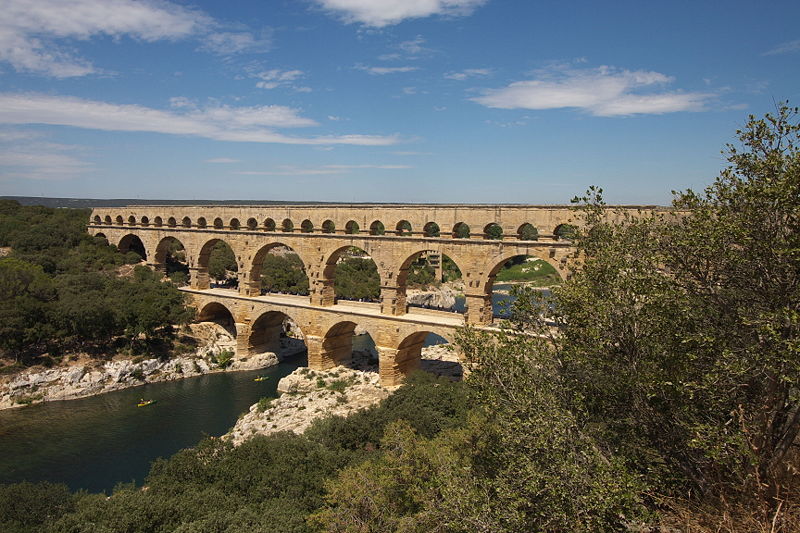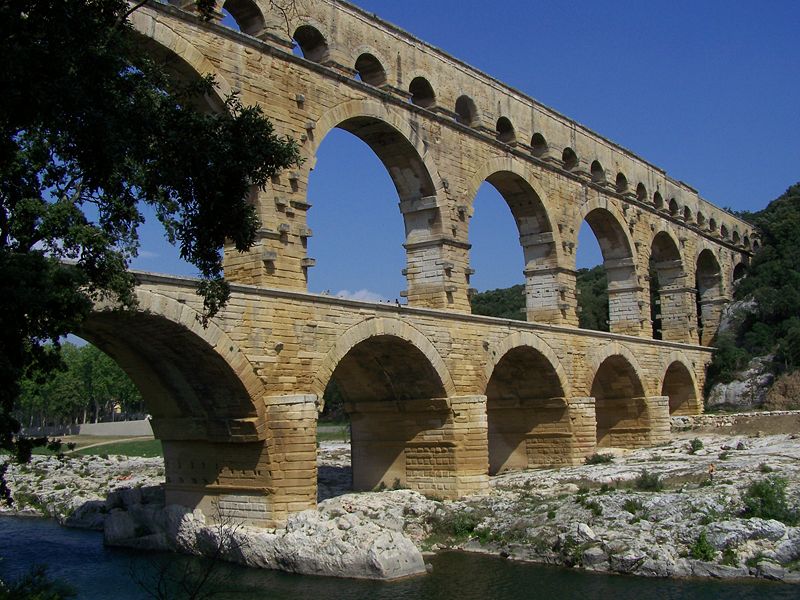Bridge of the Gard
The Bridge of the Gard, vestige of the famous Roman aqueduct, was constructed under the Claude emperor around 50 after J.C...
Nîmes (Nemausus) was to this time, since close to one century, a city important of the province, first Caesar, then Augustus contributed to his blossoming while endowing it of battlements and various monuments. However the source of the fountain that very certainly contributed to the implantation of a habitat since VI ème century. av. J.C. was not sufficient to the urban expansion of the city and his needs anymore in water.
 The decision to provide Nîmes of a collective water adduction was taken, but it was necessary to find a sufficiently abundant water source that would have a regular debit as well as a water of good quality. Rivers, including the Roach were separated of the fact of their irregular debit. The source of Eure filled these conditions. So Romen constructed the aqueduct of Uzès until Nîmes. The first flights appeared since the stake in water of the aqueduct, the reduction of the slope between Verses Bridge of the Gard and Remoulins was the reason of the overflow of the distribution basin in this sector. The height of the channel was taken on
The decision to provide Nîmes of a collective water adduction was taken, but it was necessary to find a sufficiently abundant water source that would have a regular debit as well as a water of good quality. Rivers, including the Roach were separated of the fact of their irregular debit. The source of Eure filled these conditions. So Romen constructed the aqueduct of Uzès until Nîmes. The first flights appeared since the stake in water of the aqueduct, the reduction of the slope between Verses Bridge of the Gard and Remoulins was the reason of the overflow of the distribution basin in this sector. The height of the channel was taken on
Close to 6 km and works of art of this zone were reinforced, to the exception of the Bridge of the Gard.
He would seem that the own water to the consumption was transported until the first half of the IIIème century, followed a period of illicit taking that irrigated the countryside. So the aqueduct would not have carried anymore that a water of bad quality to agricultural or industrial use.
As soon as his function first was abandoned (between the Vème and the VIIème century), the aqueduct was wild depredation victim because it represented a source important of construction materials. The saved sections correspond to zones difficult of access. The Bridge of the Gard him even was not treated tactfully, his first twelve arks and the wall carrier of the channel that preceded it disappeared.
To the Middle Ages one fixed to the work of art a new function of road passage, that made the object of a toll besides as testifies the transfer of this right of it by Philippe the Beautiful to the Lord of Uzès.
It is in the beginning the XVIIIème century (1699-1704) that was undertaken the first real restoration, financed by states of the Languedoc, that consisted in re-floating arks of the second floor, that is to say to suppress the dangerous necklines. The engineer Pitot had the load later a few times to couple a road bridge to the downstream of the building (1743-1747), the clearing of the Roach was preserved therefore without danger for the monument.
To the XIXème century many architects applied to restore the Bridge of the Gard; among them, Questel, to that one owes the staircase to screw of the left strand,; Jean-Claude Laisné drove an enormous yard that required the stake in œuvre of 2500 m3 of stone (of 1855 to 1858), the Bridge of the Gard finally recovered his primitive aspect and his beautiful proportions. He was some among them that had the incredible ambition to clear the aqueduct, some projects even kick out a beginning of realization, this is how was dug in 1863, the tunnel that opens up to the exit of the Bridge of the Gard, side clinches right.

In 1914 the Historic Monument legislation is established, the Bridge of the Gard counts naturally among them and in 1985 it is written down to the World heritage by the Unesco.
In 1996, the site of the Bridge of the Gard made the object of a tourist planning project that saw the day in the year 2000.
Today, at the time of your visit on the Site of the Bridge of the Gard, don't lack to give back you in the various spaces of discoveries: the museum, the Ludo, memory of garrigue, and the ciné.
The beauty of the Bridge of the Gard is owed to his simplicity and his size. His height and the exceptional width of his arches contributed to give back it famous and conferred him this surprising lightness pace.
Lasted of construction and working
It will have been necessary between 10 and 15 years for the construction of the aqueduct of which 5 years for the construction of the Bridge of the Gard.
The aqueduct transported the water of Uzès in Nîmes during close to 5 centuries, of 50 after J.C. in the beginning of the VIème century.
Length
Well that about twenty km separates the starting point of the aqueduct of his point of arrival, he totals close to 50 km of sinuous tracing, presenting some various obstacles (valleys, ditches, mountains) that were by turns, happy dug either. Nothing stopped the Roman genius, not same the deep valley of the Roach, that was cleared, thanks to the main piece of the aqueduct, The Bridge of the Gard.
Place of departure - place of arrival
Water left from the Source of Eure to Uzès situated to 71,25 meters of altitude to throw itself/themselves to the Castellum Divisarium (Castle of water), street of the Lampèze in Nîmes, situated to 59,95 meters of altitude. Either a general subsidence of 12,29 meters and a general middle slope of 24,80 cm km.
Debit and speed
In the first times the debit of water was 400 liters second, at the end of the working it was only 100 liters second.
Between Uzès and Nîmes, the time of transit means in period of full working was 24 at 30 o'clock.
The channel
Water circulated in a channel situated to the last floor of the aqueduct, this one measures 1m20 of width and 1m80 of height.
Materials of construction
The material that served to the construction of the Bridge of the Gard comes from two careers situated on the left strand of the Bridge of the Gard. This rock of a tender enough limestone, easy to work, doesn't fear frosts and hardens by the effect of time. The fine free dust at the time of the pose mingled himself to water that one made flow between surfaces and welded stones the some to others.
The total mass of the Bridge of the Gard is 50 400 tons!
THE BRIDGE OF THE GARD - in numbers
Total height:
48m 77 to the over of the low waters of the Roach.
Lower floor: 6 arks
- 142 ms of length
- 6 ms of width
- 22 ms of height
Middle floor: 11 arks
- 242 ms of length
- 4 ms of width
- 20 ms of height
Superior floor: 35 arks
- 275 ms of length
- 3 ms of width
- 7 ms of height
THE BRIDGE OF THE GARD - in dates
- 1st century After J.C.: construction of the Bridge of the Gard.
- 1295: right of toll to pass a strand to the other.
- 1448: earthquake on the region of Nîmes.
- 1629: (16 June) Richelieu stays to the castle of St Privât and concludes the peace of Alès there with the Protestant.
- 1699/1704: first restoration of the Bridge by states of the Languedoc.
- 1743/1747: construction of the leaning against road bridge the building by the engineer Pitot of Aramon.
- 1832: construction of the suspended Bridge of Remoulins (IMH) by the engineer Seguin. (Remain the culée, 2 columns, 2 adjoining buildings)
- 1843/1845: first real restoration by Prosper Mérimée.
- 1855/1858: 2èmth left and completion of the restoration.
- 1985: Registered to the world heritage of the the UNESCO.
- 1996/2000: Project of planning and realization.
- 2000: Inauguration of discovery spaces on the Site of the Bridge of the Gard.
- 2004: Stamp Big Site of France

